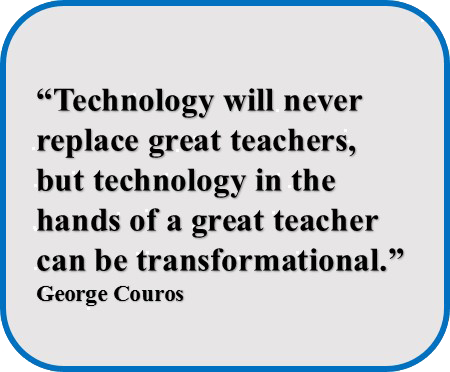
Literature Cited:
Alterman,richard, and Johann Ari Larusson (2013). "Participation and Common Knowledge in a Case Study of Student
Blogging." International Journal of Computer-Supported
Collaborative Learning, 8(2), 149-187.
Courts,
Evan, K., "Blogging in classroom – How to get started."
Retrieved from
https://startbloggingonline.com/get-started-classroom-blogging/, December 15,
2016.
Harlan-Haughey, Sarah, Taylor Cunningham,
Katherine Lees, and Andrew Estrup (2016). "Blogging to Develop Honors Students' Writing."
Journal of the National Collegiate Honors Council, 17(1), 271-287.
Jacobs, G.E.
(2008). People, purposes, and practices: Insights from cross-displinary research into instant messaging. In J. Coiro, M. Knobel, C. Lankshear, & D.J. Leu (Eds.),
The handbook of research on new literacies (pp.
467-490).
Lacina, J.,
& Block, C.C. (2012). Progressive writing instruction: Empowering
school leaders and teachers. Voices From the Middle,
19(3), 10-17.
Lenhart, A. (2008). Writing, technology
and teens.
Lin, Ming Huei, and Lin (2015).
"Learner-centered Blogging: A Preliminary Investigation of EFL Student
Writers' Experience." Educational Technology &
Society, 18(4), 446.
Partnership for 21st-century Skills. (2009).
Framework for 21st-century learning. Retrieved March 26,2017, from www.p21.org/storage/documents/P21_ Framework.pdf
Sweeny, S. (2010). Writing for the instant messaging and
text messaging generation: Using new literacies to
support writing instruction. Journal of Adolescent & Adult Literacy, 54(2),
121-130. doi:10.1598/ JAAL.54.2.4
Yang, C, and Y. ‐S Chang (2012). "Assessing the Effects of Interactive Blogging on Student Attitudes Towards Peer Interaction, Learning Motivation, and Academic Achievements." Journal of Computer Assisted Learning, 28(2), 126-135.













